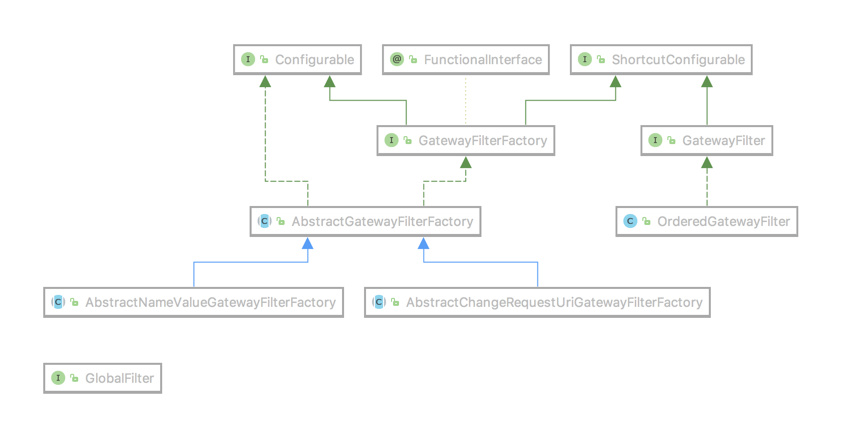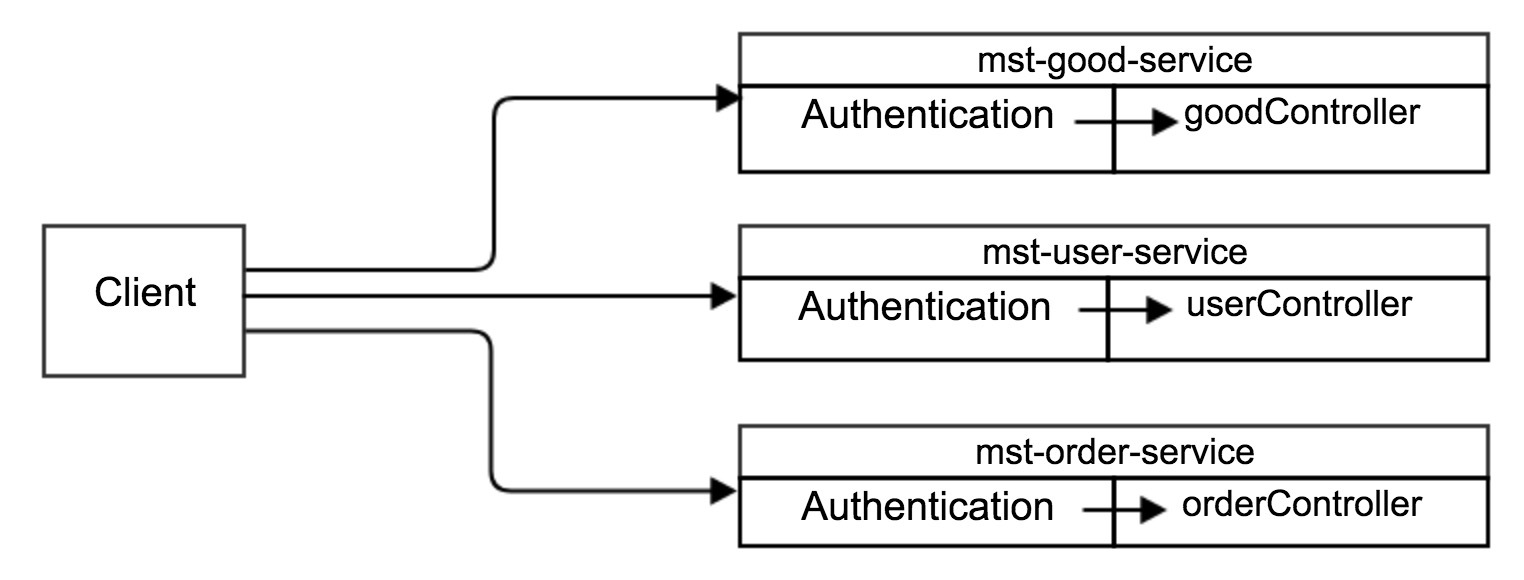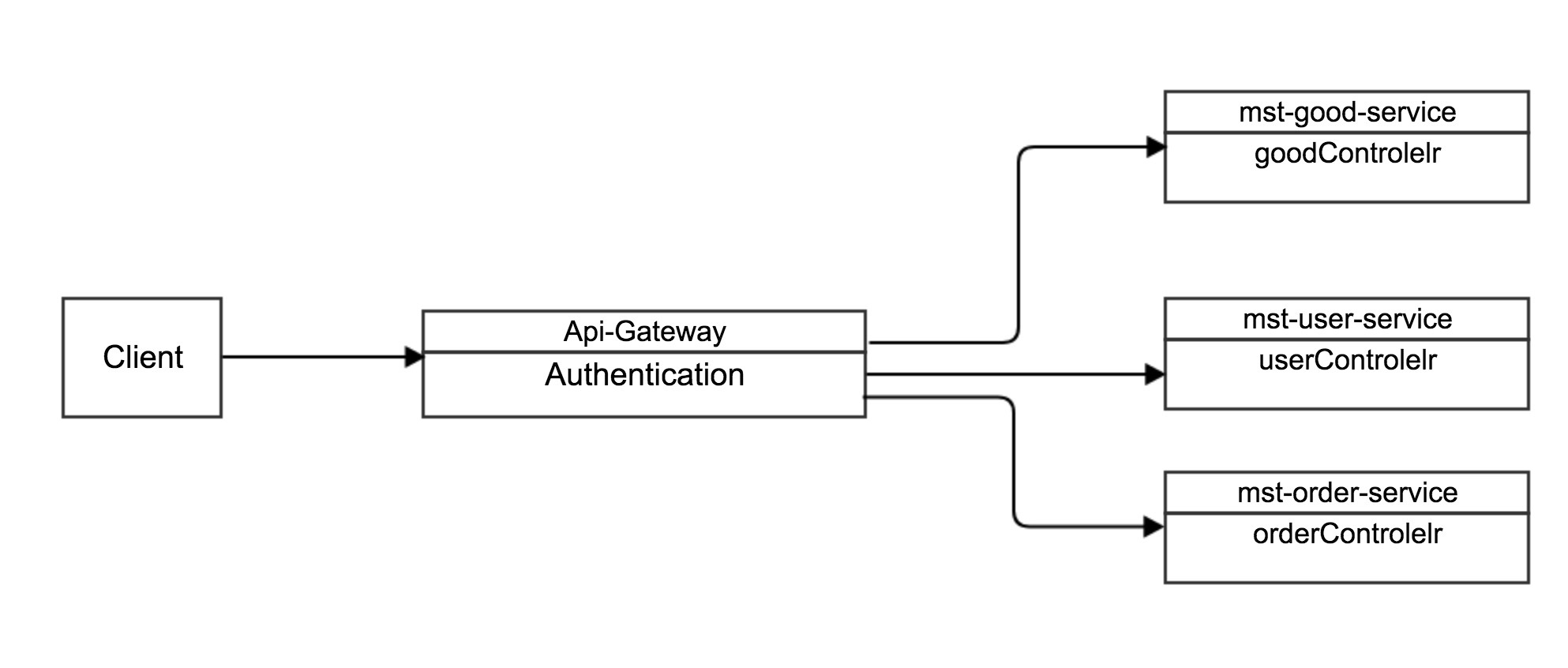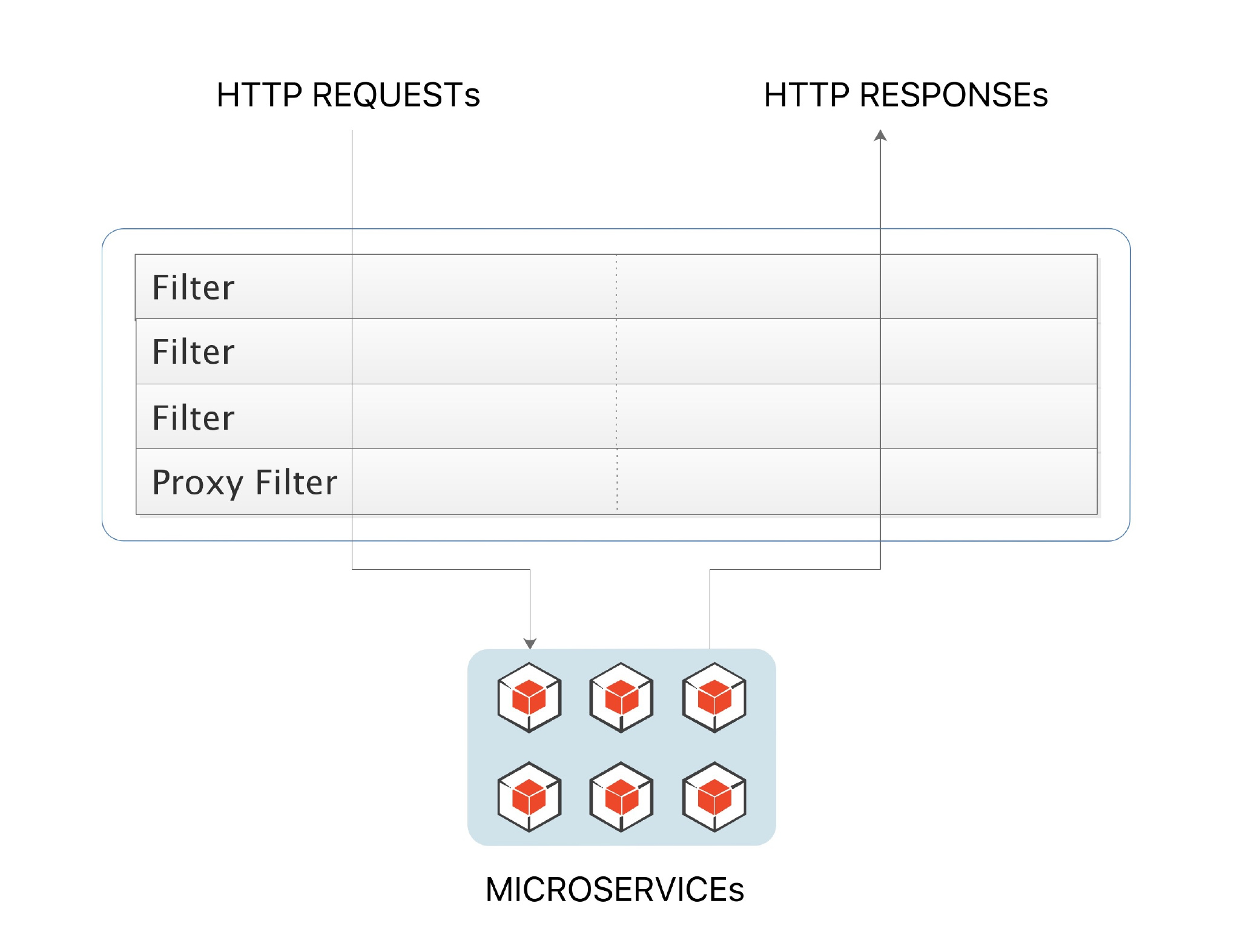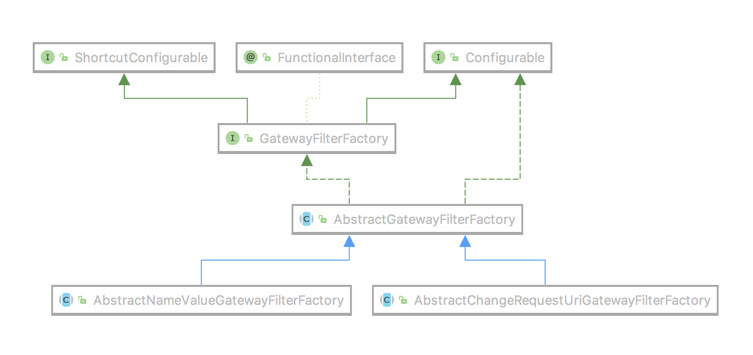在上一篇文章 中,我们了解了 Spring Cloud Gateway 作为网关所具备的基础功能:路由。本篇我们将关注它的另一个功能:过滤器。
Spring Cloud Gateway 已经内置了很多实用的过滤器,但并不能完全满足我们的需求。本文我们就来实现自定义过滤器。虽然现在 Spring Cloud Gateway 的文档还不完善,但是我们依旧可以照猫画虎来定制自己的过滤器。
Filter 的作用 其实前边在介绍 Zuul 的的时候已经介绍过 Zuul 的 Filter 的作用了,同作为网关服务,Spring Cloud Gateway 的 Filter 作用也类似。
这里就简单用两张图来解释一下吧。
当使用微服务构建整个 API 服务时,一般有许多不同的应用在运行,如上图所示的mst-user-service、mst-good-service和mst-order-service,这些服务都需要对客户端的请求的进行 Authentication。最简单粗暴的方法就是像上图一样,为每个微服务应用都实现一套用于校验的过滤器或拦截器。
对于这样的问题,更好的做法是通过前置的网关服务来完成这些非业务性质的校验,就像下图
Filter 的生命周期 Spring Cloud Gateway 的 Filter 的生命周期不像 Zuul 的那么丰富,它只有两个:“pre”和“post”。
“pre”和“post”分别会在请求被执行前调用和被执行后调用,和 Zuul Filter 或 Spring Interceptor 中相关生命周期类似,但在形式上有些不一样。
Zuul 的 Filter 是通过filterType()方法来指定,一个 Filter 只能对应一种类型,要么是“pre”要么是“post”。Spring Interceptor 是通过重写HandlerInterceptor中的三个方法来实现的。而 Spring Cloud Gateway 基于 Project Reactor 和 WebFlux,采用响应式编程风格,打开它的 Filter 的接口GatewayFilter你会发现它只有一个方法filter。
仅通过这一个方法,怎么来区分是“pre”还是“post”呢?我们下边就通过自定义过滤器来看看。
自定义过滤器 现在假设我们要统计某个服务的响应时间,我们可以在代码中
1 2 3 4 long beginTime = System.currentTimeMillis();long elapsed = System.currentTimeMillis() - beginTime;"elapsed: {}ms" , elapsed);
每次都要这么写是不是很烦?Spring 告诉我们有个东西叫 AOP。但是我们是微服务啊,在每个服务里都写也很烦。这时候就该网关的过滤器登台表演了。
自定义过滤器需要实现GatewayFilter和Ordered。其中GatewayFilter中的这个方法就是用来实现你的自定义的逻辑的
1 Mono<Void> filter (ServerWebExchange exchange, GatewayFilterChain chain) ;
而Ordered中的int getOrder()方法是来给过滤器设定优先级别的,值越大则优先级越低。
好了,让我们来撸代码吧
1 2 3 4 5 6 7 8 9 10 11 12 13 14 15 16 17 18 19 20 21 22 23 24 25 26 27 28 29 30 31 import org.apache.commons.logging.Log;import org.apache.commons.logging.LogFactory;import org.springframework.cloud.gateway.filter.GatewayFilter;import org.springframework.cloud.gateway.filter.GatewayFilterChain;import org.springframework.core.Ordered;import org.springframework.web.server.ServerWebExchange;import reactor.core.publisher.Mono;public class ElapsedFilter implements GatewayFilter , Ordered {private static final Log log = LogFactory.getLog(GatewayFilter.class);private static final String ELAPSED_TIME_BEGIN = "elapsedTimeBegin" ;@Override public Mono<Void> filter (ServerWebExchange exchange, GatewayFilterChain chain) {return chain.filter(exchange).then(Long startTime = exchange.getAttribute(ELAPSED_TIME_BEGIN);if (startTime != null ) {": " + (System.currentTimeMillis() - startTime) + "ms" );@Override public int getOrder () {return Ordered.LOWEST_PRECEDENCE;
我们在请求刚刚到达时,往ServerWebExchange中放入了一个属性elapsedTimeBegin,属性值为当时的毫秒级时间戳。然后在请求执行结束后,又从中取出我们之前放进去的那个时间戳,与当前时间的差值即为该请求的耗时。因为这是与业务无关的日志所以将Ordered设为Integer.MAX_VALUE以降低优先级。
现在再来看我们之前的问题:怎么来区分是“pre”还是“post”呢?其实就是chain.filter(exchange)之前的就是“pre”部分,之后的也就是then里边的是“post”部分。
创建好 Filter 之后我们将它添加到我们的 Filter Chain 里边
1 2 3 4 5 6 7 8 9 10 11 12 13 14 15 @Bean public RouteLocator customerRouteLocator (RouteLocatorBuilder builder) {return builder.routes()"/fluent/customer/**" )2 )new ElapsedFilter ())"X-Response-Default-Foo" , "Default-Bar" ))"lb://CONSUMER" )0 )"fluent_customer_service" )
现在再尝试访问 http://localhost:10000/customer/hello/yibo 即可在控制台里看到请求路径与对应的耗时
1 2018-05-08 16:07:04.197 INFO 83726 --- [ctor-http-nio-4] o.s.cloud.gateway.filter.GatewayFilter : /hello/yibo: 40ms
实际在使用 Spring Cloud 的过程中,我们会使用 Sleuth+Zipkin 来进行耗时分析 。
自定义全局过滤器 前边讲了自定义的过滤器,那个过滤器只是局部的,如果我们有多个路由就需要一个一个来配置,并不能 通过像下面这样来实现全局有效(也未在 Fluent Java API 中找到能设置 defaultFilters 的方法)
1 2 3 4 @Bean public ElapsedFilter elapsedFilter () {return new ElapsedFilter ();
这在我们要全局统一处理某些业务的时候就显得比较麻烦,比如像最开始我们说的要做身份校验,有没有简单的方法呢?这时候就该全局过滤器出场了。
有了前边的基础,我们创建全局过滤器就简单多了。只需要把实现的接口GatewayFilter换成GlobalFilter,就完事大吉了。比如下面的 Demo 就是从请求参数中获取token字段,如果能获取到就 pass,获取不到就直接返回401错误,虽然简单,但足以说明问题了。
1 2 3 4 5 6 7 8 9 10 11 12 13 14 15 16 17 18 19 20 21 22 23 24 import org.springframework.cloud.gateway.filter.GatewayFilterChain;import org.springframework.cloud.gateway.filter.GlobalFilter;import org.springframework.core.Ordered;import org.springframework.http.HttpStatus;import org.springframework.web.server.ServerWebExchange;import reactor.core.publisher.Mono;public class TokenFilter implements GlobalFilter , Ordered {@Override public Mono<Void> filter (ServerWebExchange exchange, GatewayFilterChain chain) {String token = exchange.getRequest().getQueryParams().getFirst("token" );if (token == null || token.isEmpty()) {return exchange.getResponse().setComplete();return chain.filter(exchange);@Override public int getOrder () {return -100 ;
然后在 Spring Config 中配置这个 Bean
1 2 3 4 @Bean public TokenFilter tokenFilter () {return new TokenFilter ();
重启应用就能看到效果了
1 2 2018-05-08 20:41:06.528 DEBUG 87751 --- [ctor-http-nio-2] o.s.c.g.h.RoutePredicateHandlerMapping : Mapping [Exchange: GET http://localhost:10000/customer/hello/yibo?token=1000] to Route{id='service_customer', uri=lb://CONSUMER, order=0, predicate=org.springframework.cloud.gateway.handler.predicate.PathRoutePredicateFactory$$Lambda$334/1871259950@2aa090be, gatewayFilters=[OrderedGatewayFilter{delegate=org.springframework.cloud.gateway.filter.factory.StripPrefixGatewayFilterFactory$$Lambda$337/577037372@22e84be7, order=1}, OrderedGatewayFilter{delegate=org.springframework.cloud.gateway.filter.factory.AddResponseHeaderGatewayFilterFactory$$Lambda$339/1061806694@1715f608, order=2}]}
官方说,未来的版本将对这个接口作出一些调整:Spring Cloud Gateway - Global Filters
自定义过滤器工厂 如果你还对上一篇关于路由的文章有印象,你应该还得我们在配置中有这么一段
1 2 3 filters: - StripPrefix=1 - AddResponseHeader=X-Response-Default-Foo, Default-Bar
StripPrefix、AddResponseHeader这两个实际上是两个过滤器工厂(GatewayFilterFactory),用这种配置的方式更灵活方便。
我们就将之前的那个ElapsedFilter改造一下,让它能接收一个boolean类型的参数,来决定是否将请求参数也打印出来。
1 2 3 4 5 6 7 8 9 10 11 12 13 14 15 16 17 18 19 20 21 22 23 24 25 26 27 28 29 30 31 32 33 34 35 36 37 38 39 40 41 42 43 44 45 46 47 48 49 50 51 52 53 54 55 56 57 58 59 60 import org.apache.commons.logging.Log;import org.apache.commons.logging.LogFactory;import org.springframework.cloud.gateway.filter.GatewayFilter;import org.springframework.cloud.gateway.filter.factory.AbstractGatewayFilterFactory;import reactor.core.publisher.Mono;import java.util.Arrays;import java.util.List;public class ElapsedGatewayFilterFactory extends AbstractGatewayFilterFactory <ElapsedGatewayFilterFactory.Config> {private static final Log log = LogFactory.getLog(GatewayFilter.class);private static final String ELAPSED_TIME_BEGIN = "elapsedTimeBegin" ;private static final String KEY = "withParams" ;@Override public List<String> shortcutFieldOrder () {return Arrays.asList(KEY);public ElapsedGatewayFilterFactory () {super (Config.class);@Override public GatewayFilter apply (Config config) {return (exchange, chain) -> {return chain.filter(exchange).then(Long startTime = exchange.getAttribute(ELAPSED_TIME_BEGIN);if (startTime != null ) {StringBuilder sb = new StringBuilder (exchange.getRequest().getURI().getRawPath())": " )"ms" );if (config.isWithParams()) {" params:" ).append(exchange.getRequest().getQueryParams());public static class Config {private boolean withParams;public boolean isWithParams () {return withParams;public void setWithParams (boolean withParams) {this .withParams = withParams;
过滤器工厂的顶级接口是GatewayFilterFactory,我们可以直接继承它的两个抽象类来简化开发AbstractGatewayFilterFactory和AbstractNameValueGatewayFilterFactory,这两个抽象类的区别就是前者接收一个参数(像StripPrefix和我们创建的这种),后者接收两个参数(像AddResponseHeader)。
GatewayFilter apply(Config config)方法内部实际上是创建了一个GatewayFilter的匿名类,具体实现和之前的几乎一样,就不解释了。
静态内部类Config就是为了接收那个boolean类型的参数服务的,里边的变量名可以随意写,但是要重写List<String> shortcutFieldOrder()这个方法。
这里注意一下,一定要调用一下父类的构造器把Config类型传过去,否则会报ClassCastException
1 2 3 public ElapsedGatewayFilterFactory () {super (Config.class);
工厂类我们有了,再把它注册到 Spring 当中
1 2 3 4 @Bean public ElapsedGatewayFilterFactory elapsedGatewayFilterFactory () {return new ElapsedGatewayFilterFactory ();
然后添加配置(主要改动在第 8 行)
1 2 3 4 5 6 7 8 9 10 11 12 13 14 15 16 17 spring: cloud: gateway: discovery: locator: enabled: true default-filters: - Elapsed=true routes: - id: service_customer uri: lb://CONSUMER order: 0 predicates: - Path=/customer/** filters: - StripPrefix=1 - AddResponseHeader=X-Response-Default-Foo, Default-Bar
然后我们再次访问 http://localhost:10000/customer/hello/yibo?token=1000 即可在控制台看到以下内容
1 2018-05-08 16:53:02.030 INFO 84423 --- [ctor-http-nio-1] o.s.cloud.gateway.filter.GatewayFilter : /hello/yibo: 656ms params:{token=[1000]}
总结 本文主要介绍了 Spring Cloud Gateway 的过滤器,我们实现了自定义局部过滤器、自定义全局过滤器和自定义过滤器工厂,相信大家对 Spring Cloud Gateway 的过滤器有了一定的了解。之后我们将继续在过滤器的基础上研究 如何使用 Spring Cloud Gateway 实现限流和 fallback。
示例代码可以从 Github 获取:https://github.com/zhaoyibo/spring-cloud-study
参考 spring-cloud/spring-cloud-gateway Spring Cloud Gateway
